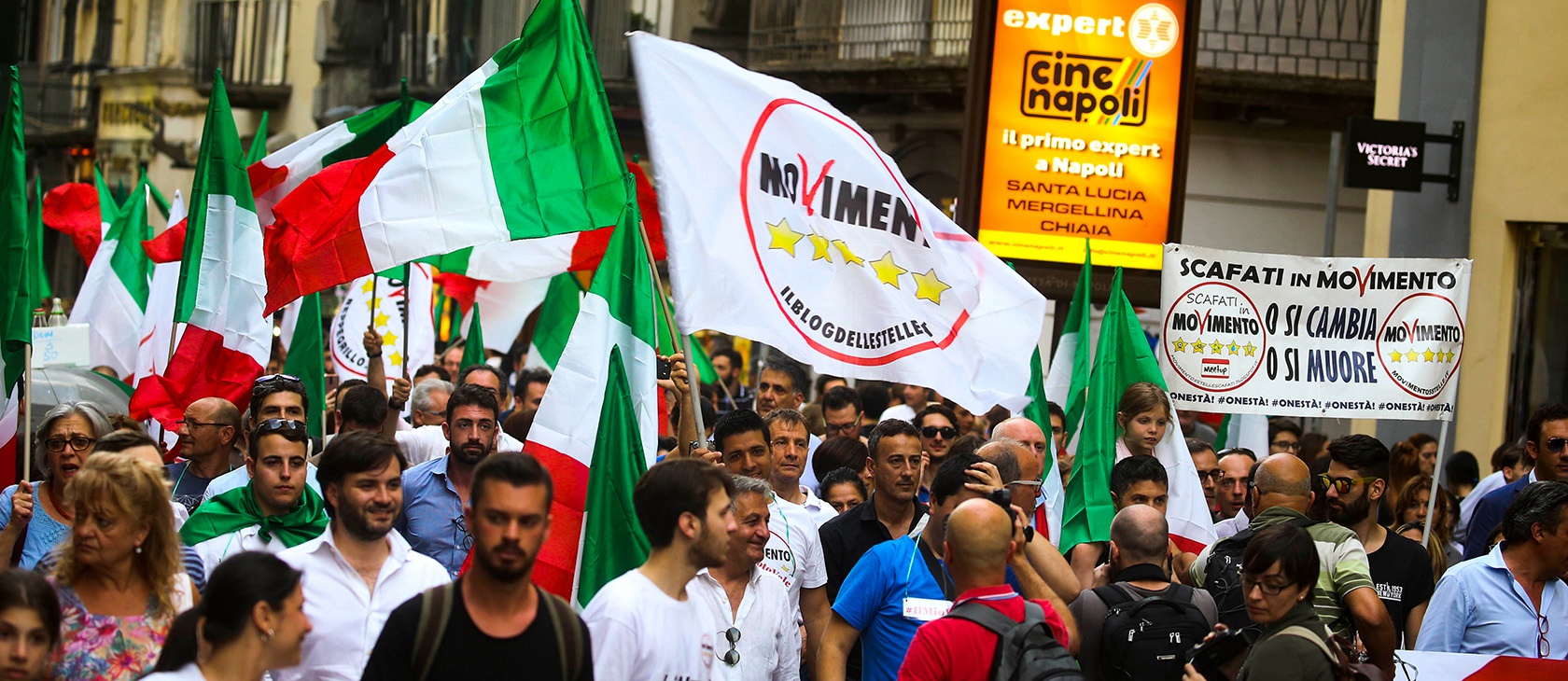The new Italian government is a very strange creature. It’s easy to define it as a “populist” government, but that is surely an oversimplification. It is formed by two very different political forces: the Lega (League) and the Five Star Movement, which were not allied during the 2018 general elections. As all pundits rightly forecasted, no coalition nor party won the majority. But no one forecasted two anomalies: the League trounced the party founded by former prime minister Silvio Berlusconi, Forza Italia (literally “Forward Italy”), becoming the largest political force on the center-Right for the first time since 1994. The second was the huge success of the Five Star Movement – a movement formed just six years ago – which became the kingmaker after winning more than 30 percent of the vote.
These unpredictable results provoked the quick collapse of the center-Right coalition and the formation of a new, unprecedented majority: the Five Star Movement and the League. But the coalition is not as natural as it has been portrayed outside Italy.
Who makes up the new coalition?
The League was founded in 1982 by former Communist sympathiser Umberto Bossi as the Lega Lombarda, a tiny autonomist party in the northern Italian region of Lombardy. It’s worth remembering that, in Europe during the late 1970s and early 1980s, autonomist movements were always leftist. The desire for regional autonomy, along with pacifism such as anti-NATO and anti-nuclear protests, were all part of the early anti-globalisation movement. Joining forces with the Veneto autonomist party, the Liga Veneta, and other similar movements in northern Italy, Bossi formed the Lega Nord (Northern League). Their first breakthrough came in the 1992 general elections, during a very special historical period: The Soviet Union and Yugoslavia had just collapsed, and nationalist and autonomist ideas ran rampant over Europe. But the Northern League didn’t promote full independence in those years.
What do the League and Five Star have in common? They share a powerful bond: their struggle against the free market and globalisation.
Despite Bossi’s Communist origins, he formed a coalition with the TV mogul Berlusconi. Together, they won the general elections of 1994 aiming to bring greater economic freedom to Italy, which is still one of the most statist economies in Western Europe. The interests of northern regions, industries, and productive taxpayers aligned against the tax-consumers of the central government. Thus, the alliance with Berlusconi seemed natural, similar to the libertarian-conservative alliance inside the U.S. Republican Party. But a harsh clash of personalities between Bossi and Berlusconi led to the split of their center-Right coalition after just six months.
Then the party embarked on a short period promoting genuine nationalism: The Northern League, since 1996 aimed explicitly at the independence of the northern regions of Italy, calling them by the geographical neologism of “Padania” (after the name of north Italian plain).
It was in this period that the Northern League established ties with Serbian nationalists and the Russian far-Right. At the time these relationships seemed to be of secondary importance, but they are pivotal to understand recent developments. During the 1999 NATO intervention against Kosovo, the Northern League was strongly pro-Milosevic and its links with Russia tightened. After the 1999 European elections, the Northern League suffered an electoral and financial backlash and in 2001, Berlusconi approached Bossi again to form the new center-Right coalition. The Northern League remained a loyal ally from 2001 to 2011, when the last Berlusconi government fell. In that period, the League downplayed its nationalism (although, it was still named the “Northern League for the independence of Padania” until 2015), and its sympathies for Russian nationalism were put on the shelf. Everything changed again in 2011, when the center-Right government fell once more.
The League was pressed by an electoral crisis and a corruption trial. Bossi was replaced by the new young secretary Matteo Salvini. The new leader, sensing the nationalist renaissance all over Europe, completely changed the shape and the ideology of the party. The mission of the League was no longer securing the independence of the northern regions from the rest of Italy, but that of the whole of Italy from the new European Union super-State. In just three years, he transformed the former autonomist/pro-independence Northern League into a full-blown nationalist force inspired by Marine Le Pen’s National Front. Ties with the Russian far-Right again strengthened. Salvini’s speeches have the same emphasis: Immigration, terrorism, social crises, and the economic crisis are all evils originating from, or worsened by, the EU as part of the global financiers’ hidden agenda to replace European peoples. Salvini has presented this as the “genocide” of European native peoples, perpetrated as part of a grand conspiracy.
The Five Star Movement’s story is shorter. It was born in part from the large communications company Casaleggio Associates, which led the online protest against Italy’s economic and political establishment. Its founder, Gianroberto Casaleggio (who died in 2016) had his own “prophetic” vision of the future of politics that involved direct control by the people through the internet, establishing a world government, and completing an environmentalist and economic revolution.
More and more Catholics in Italy are attracted by anti-capitalist rhetoric, even considering global capitalism the root of all moral evils.
The party’s first public face was the very popular comedian/activist Beppe Grillo. He scored well in the 2013 general election, making the movement the largest party, but not large enough to form a government. Nor could he be accepted as the junior party of the center-Left Democratic Party. Luigi Di Maio took control of the party in 2018 because, according to one of the Movement’s many internal rules, no one could lead the party for two consecutive legislatures. All candidates are chosen through online primary elections, but only a few tens of thousands of militants and sympathizers voted via the party’s web platform called “Rousseau” (after the eighteenth-century French philosopher is the main influence of the Movement’s agenda). In a time of deep economic crisis, the Five Star Movement events filled the streets all over Italy, mobilizing people through the skilled use of social media. Curiously, public support flagged for its environmentalist platform and all its planks: slowing economic growth, promoting the “sharing economy,” enacting a radical renewable energy plan, and discarding GDP measures with a “Gross National Happiness” index. But apparently its supporters were (and still are) attracted by two things: the party’s struggle against corruption and its promise of a universal basic income.
Statism triumphs over moral issues
What do the League and Five Star have in common? They share a powerful bond: their struggle against the free market and globalisation. While Salvini’s new League strongly opposes global capitalism in defence of national identity, the Five Star Movement opposes the market due to its radical environmentalist ideology.
The parties also share another common link: Vladimir Putin. Since 2016, the League is formally associated to United Russia, Putin’s own party. The Five Star Movement is not officially tied to the Kremlin but always countered EU sanctions against Russia, and has almost always supported the Kremlin since the Ukrainian crisis in 2014. Both parties oppose the Western liberal order based on the EU and NATO and strongly push for its revision, which benefits Russia.
The new government could give birth to a new form of intellectual fusionism based on anti-capitalist ideology. And this is not good news for anyone concerned.
The parties’ main divide comes over religion and individual rights. The Five Star Movement, being a hard-Left movement, absorbed all the secularism of the old Left. Gay marriage, gay adoptions, euthanasia, and loosening restrictions on abortion are all on their agenda – and are still applied locally by Five Star’s elected officials. On the other side, the League opposed all of these causes, considering them evils imposed by the EU’s “globalist agenda” to eradicate tradition. The League nominated perhaps the most Catholic minister in recent Italian history, Lorenzo Fontana, as the Minister for the Family and Disability. Fontana opposes all the newly invented sexual rights, is consistently pro-life, and favours home schooling – which is exceedingly uncommon in Italy.
Are the centrifugal forces of the “new rights” movement stronger than the parties’ common ground on economics and foreign policy?
Catholic voters’ values will determine Italy’s future
Italy’s future depends entirely on Catholic voters. If they consider the Five Star Movement unpalatable because of its views on human nature, the coalition will split. If they consider the struggle against “global capitalism” more important than the principles of life and family, then they will support the new coalition with enthusiasm.
More and more Catholics in Italy are attracted by anti-capitalist rhetoric, even considering global capitalism the root of all moral evils, including abortion, gay marriage, euthanasia, and so on. This is a message constantly spread by many influential Catholic blogs in Italy, by young intellectuals like the popular philosopher Diego Fusaro, and a new generation of “communitarian” thinkers which are proliferating on the internet and beyond.
The new government could give birth to a new form of intellectual fusionism based on anti-capitalist ideology. And this is not good news for anyone concerned.




